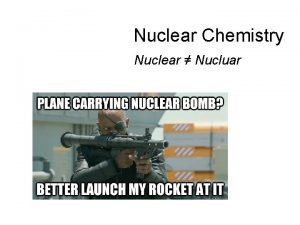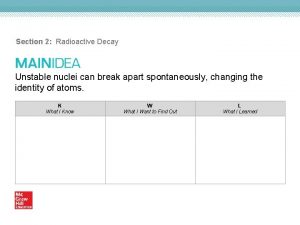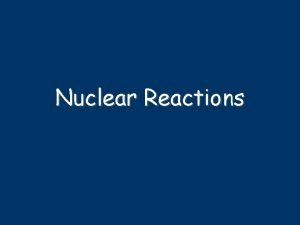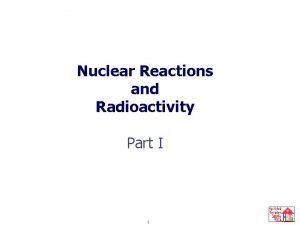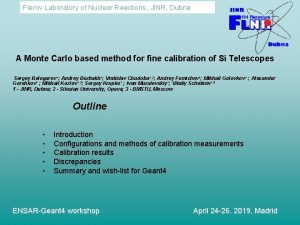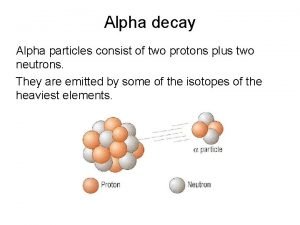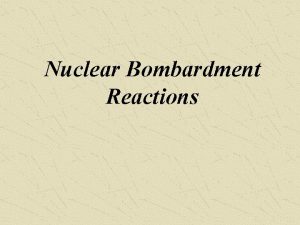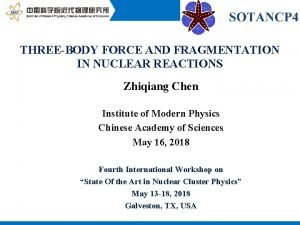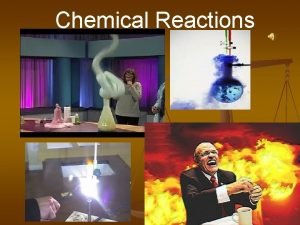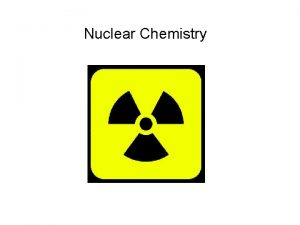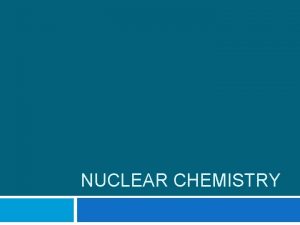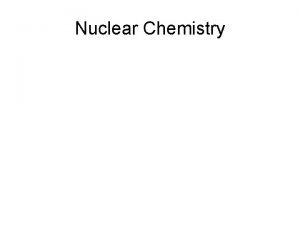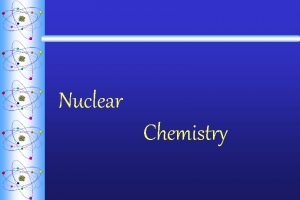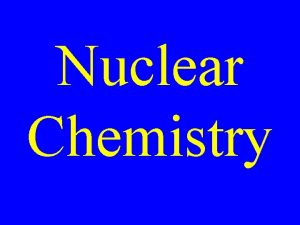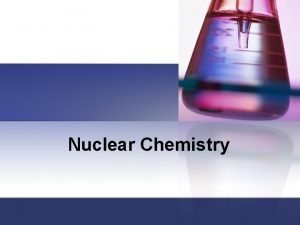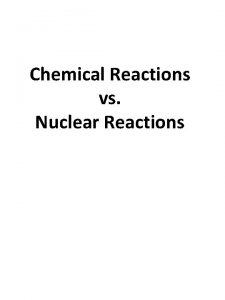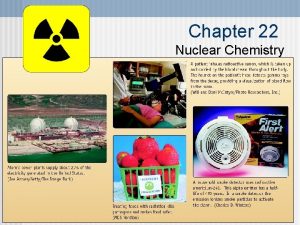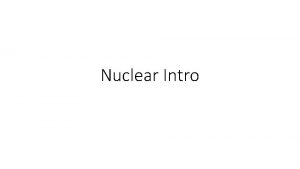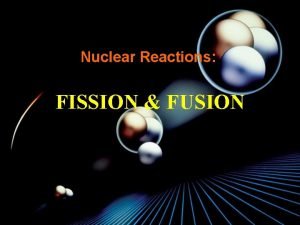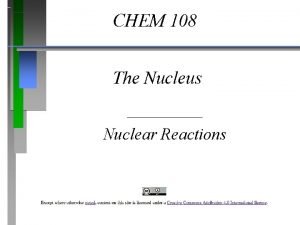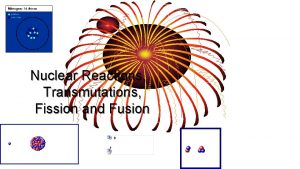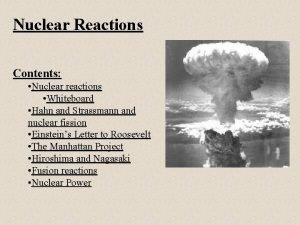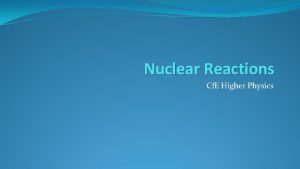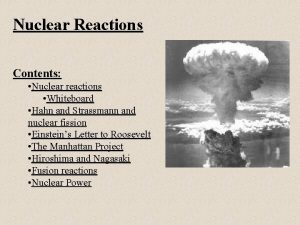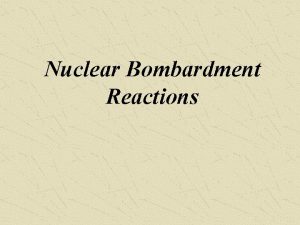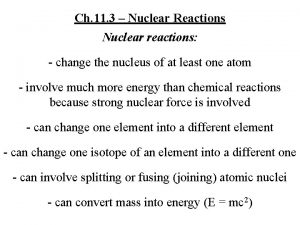Nuclear Chemistry Nuclear Nucluar Nuclear Reactions vs Normal





















- Slides: 21

Nuclear Chemistry Nuclear ≠ Nucluar

Nuclear Reactions vs. Normal Chemical Changes • • • Nuclear reactions involve the nucleus Protons and neutrons are rearranged Releases a tremendous amount of energy – called binding energy • “Normal” Chemical Reactions involve electrons, not protons and neutrons

Types of Radiation • Alpha (ά) – a helium isotope • Beta (β) – an electron • Gamma (γ) – pure energy; called a ray rather than a particle

Penetrating Ability

Other Types of Particles • Neutron • Proton • Elements will correspond to their bottom number/number of protons • Eg:

212 Po decays by alpha emission. Write the balanced nuclear equation for the decay of 212 Po. 4 alpha particle - 42 He or 2 a 212 Po 84 4 He 2 + AZX 212 = 4 + A A = 208 84 = 2 + Z Z = 82 212 Po 84 4 He 2 + 208 82 Pb 23. 1

Nuclear Stability and Radioactive Decay Beta decay 14 6 C 40 K 19 14 N + 0 b 7 -1 40 Ca 20 + -10 b Decrease # of neutrons by 1 Increase # of protons by 1 23. 2

Nuclear Stability and Radioactive Decay 55 Fe 26 + -10 e 1 p 1 55 Mn 25 + -10 e 1 n 0 +n +n Increase # of neutrons by 1 Decrease # of protons by 1 Alpha decay 212 Po 84 4 He 2 + 208 82 Pb Decrease # of neutrons by 2 Decrease # of protons by 2

Learning Check What radioactive isotope is produced in the following bombardment of boron? 10 B 5 + 4 He 2 ? + 1 n 0

Learning Check What radioactive isotope is produced in the following bombardment of boron? 10 B 5 + 4 He 2 13 N 7 + 1 n 0

Write Nuclear Equations! Write the nuclear equation for the beta emitter Co-60. 60 Co 27 0 e -1 + ? ? ?

Half-Life • HALF-LIFE is the time that it takes for 1/2 a sample to decompose.

Half-Life Decay of 20. 0 mg of 15 O. What remains after 3 half-lives? After 5 half-lives?

Sample question • How much U-238 is left over if a 100 gram sample undergoes 8 half lives?

Learning Check! The half life of I-123 is 13 hr. How much of a 64 mg sample of I-123 is left after 39 hours?

Last learning check • What fraction of an unknown mass of Iodine, which has a half life of 8 hours, would you expect to be left after 72 hours?

Nuclear Fission • Larger and unstable nuclei being bombarded with particles and breaking into smaller nuclei and releasing energy at the same time.

Mass Defect • Some of the mass can be converted into energy • Shown by a very famous equation! E=mc 2 Energy Mass Speed of light

Nuclear Fusion Small nuclei combine to make larger nuclei and release TONS of energy 2 H 4 He + 3 H + 1 n + Energy 1 1 2 0

Nuclear Fusion • Excessive heat can not be contained • Attempts at “cold” fusion have FAILED. • “Hot” fusion is difficult to contain

Summarize what you’ve learned
 Chemistry unit 5 reactions balancing reactions worksheet
Chemistry unit 5 reactions balancing reactions worksheet Lesson 15 nuclear quest nuclear reactions
Lesson 15 nuclear quest nuclear reactions Nucluar fusion
Nucluar fusion Section 2 reinforcement classifying chemical reactions
Section 2 reinforcement classifying chemical reactions Reduction half reaction
Reduction half reaction Section 2 reinforcement classifying chemical reactions
Section 2 reinforcement classifying chemical reactions Chemical reactions section 3 reactions in aqueous solutions
Chemical reactions section 3 reactions in aqueous solutions Nuclear decays and reactions section 2
Nuclear decays and reactions section 2 Two types of nuclear reactions
Two types of nuclear reactions Artificial transmutation example
Artificial transmutation example Balancing nuclear reactions
Balancing nuclear reactions Activity of radioactive sample
Activity of radioactive sample Flerov laboratory of nuclear reactions
Flerov laboratory of nuclear reactions Alpha decay of uranium-238
Alpha decay of uranium-238 Two types of nuclear reactions
Two types of nuclear reactions Nuclear bombardment
Nuclear bombardment Nuclear reactions are at
Nuclear reactions are at Key terms radioactivity and nuclear reactions
Key terms radioactivity and nuclear reactions 4 types of chemical reactions
4 types of chemical reactions 5 types of reactions chemistry
5 types of reactions chemistry Type of reactions chemistry
Type of reactions chemistry Symbols in chemical equations
Symbols in chemical equations


